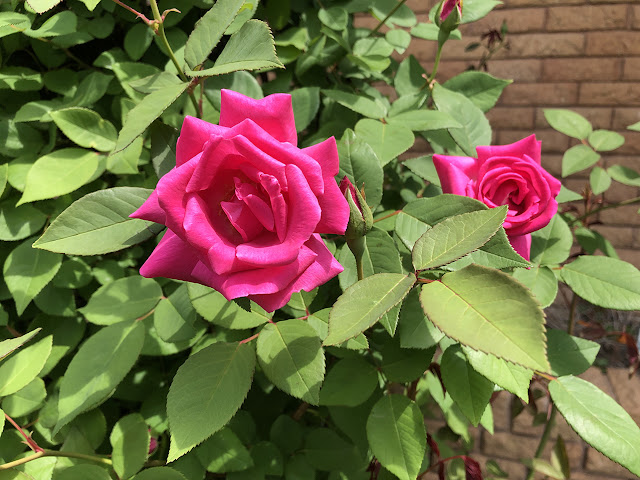By G. S. Norwood
Family Weirdness
My sister and I call ourselves the Weird Sisters, but the truth is, we are not the only eccentric people on our family tree. Not by a country mile. Trust me on this. There was, for instance, our grandmother, Ethel Briscoe Sherrell. The story of her father - our great-grandpa - and the hand-tinted photograph of an elderly farm wife with a giant rose bush, is only one example of our family weirdness.
A Picture of Pearl
 |
| The photo showed a woman standing in front of a rose bush, covered with big, deep pink roses. (Photo: G. S. Norwood). |
As long as I can remember, an old-fashioned photograph hung over Grandma Sherrell’s bed. It had a fancy wooden frame with a domed glass cover. The photo showed a woman in a plain house dress and apron, her hair pulled back in a bun, standing in front of a tall, awkwardly-shaped rose bush, covered with big, deep pink roses.
The photo must have been black and white to begin with, but my grandmother had paid to have it enlarged and hand tinted. All the other colors had faded over the years, but those fat, pink roses still glowed out of the picture, catching my eye every time. Finally, when I was in college, I asked Grandma Sherrell the history behind the photo.
“That’s the only picture I have of my mother,” she told me.
Family History
 |
| Ethel and Jack Sherrell, unlikely source of family weirdness (Sherrell Family Archive) |
Ethel was the oldest child of Ira and Pearl Thornton Briscoe. Born deep in the hills of south-central Missouri in 1904, Ethel assumed the traditional family role of helping her mother care for her seven younger brothers and sisters. She felt very close to her mother, but never cared much for her father. She told me once he was mean.
But what was the story of the rose bush? Even back then, I loved roses, and I knew my grandmother had tried to raise a few of the thorny, finicky hybrid teas that passed for commercially available roses in mid-century Missouri. The bush in the picture didn’t look like any rose I’d ever seen. True shrub roses had mostly fallen out of fashion when I was a kid, and weren’t readily available in the nurseries and garden centers around Springfield.
“My mother planted that bush down by the front gate,” my grandmother recalled. “She loved it. It had the prettiest pink flowers, and always smelled so good.”
Rose History
I could well imagine. A rose like that might offer a little oasis of beauty in the otherwise hard life of a hill country farm wife with a growing family to care for. The roses we now call antiques, like Teddy Roosevelt’s reputed favorite, Duchesse de Brabant, were fashionable shrubs around the turn of the past century. Country women often started new bushes from rooted cuttings passed from friend to friend.
 |
| The antique shrub rose Duchesse de Brabant was reportedly Teddy Roosevelt’s favorite. (Photos: Annie’s Annuals/Malcolm Manners, and The White House). |
Tragedy and Revenge
But then my grandmother’s story took a darker turn.
“One day my daddy took a notion to do some damn fool thing. Move the fence. Plant another row of beans. Something. He cut down my mother’s rose bush without even asking her.”
At this point, the story began to take on fairy tale elements for me. Didn’t Ira know you should never cut down a beloved thorn bush? That’s a sure-fire way to incur the wrath of the fairies. Or your wife.
My grandmother nodded to her photo. “My mother loved that rose bush, and never forgave him for cutting it down. In the original photo, my mother and my father both were standing there by the gate, where the rose bush used to be. It’s the only photo I have of my mother, but I never liked my father. I took the photo to the man who did enlargements and hand tinting. I asked him to blow the picture up, do the hand tinting, and paint that rose bush back where it belonged, right over the top of Daddy.”
Well.
I was both thrilled and appalled by Grandma Sherrell’s story. Appalled by the symbolic patricide of replacing her father with her mother’s lost rose bush. But also, a little thrilled to know that I was descended from such ruthlessness. Nobody ever said Grandma Sherrell was an easy woman. Yes, she was first in line to help cook church dinners and volunteer for the Navy Mothers Club. At the same time, she was sometimes impossible to please, and always quick to decide which of her acquaintances would be “in the Kingdom” come Judgement Day.
Great-Grandpa!
When Grandma died, Jan and I both wanted the picture, but our great-aunt Maxine—Ethel’s youngest sister—called dibs because it was the only photo she had of her mother, too. We have no idea where the photo is now, with Maxine long gone. The story of the rose bush, however, has stuck with both of us. And just the other day, as I was taking photos of my own rose bush, Zephirine Drouhin, I framed the shot, then looked up from my camera in shocked recognition.
 |
| G.’s own Zephrine Drouhin rose. (Photo: G. S. Norwood). |
There, looming more than six feet tall on my phone screen, was a narrow, awkwardly-shaped rose bush, covered in brilliant, fragrant pink blooms.
“Great-Grandpa!” I cried.
IMAGE CREDITS:
The Duchesse de Brabant rose photo is courtesy of “Annie’s Annuals” and photographer Malcolm Manners. The photo of Teddy Roosevelt is from The White House. The photos of Jack and Ethel Sherrell are from the Sherrell Family archive, as noted. Photos of G.’s roses (which followers of this blog may remember from last week’s post) are by G. S. Norwood. All montages assembled by Jan S. Gephardt.
No comments:
Post a Comment